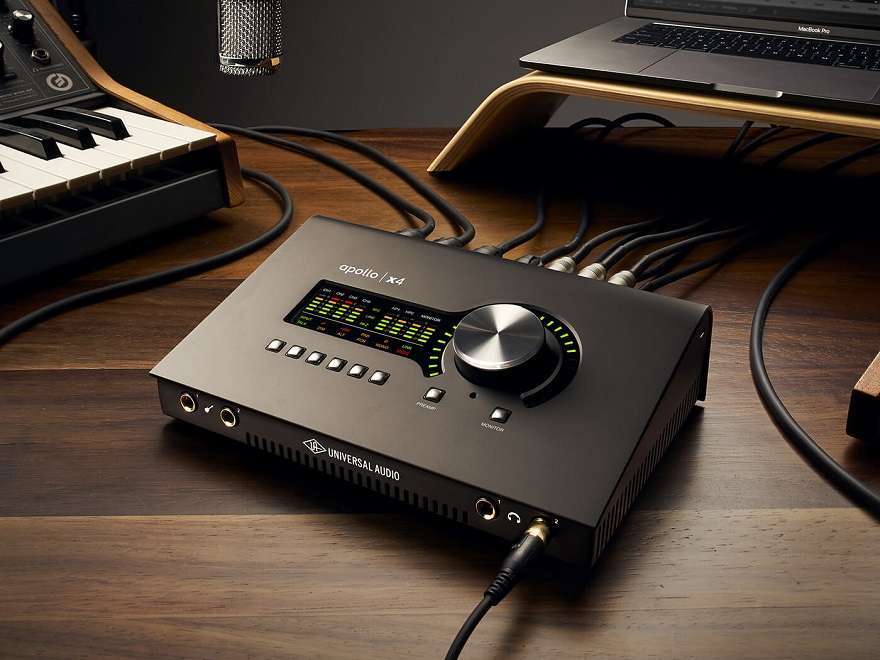Anyone who has been trained in music engineering and sound production is probably aware of the Universal Audio Apollo, or UA Audio Interface, as well as the Universal Audio brand.
The Apollo Audio Interface was first introduced in 2012 by UA. Over the years, Universal Audio has produced truly amazing hardware but the Apollo is what’s given the company their biggest hit so far. The UA Apollo is a recording interface designed to give premium A/D and D/A conversation for personal and commercial studios alike.
UA Apollo Uses The Best Digital Effects To Achieve A Beautiful Borderline-Analog Sound
Classic analog recording not only comes with its own feel in the room but produces a sound that no experienced listener would ever mistake for digital.
The frequency band on an analog capture is generally wider and captures more detail. It makes the product sound warmer than what digital has been able to manage thus far.
The Apollo, make no mistake, is a digital interface. It is designed, however, to retain the tone, feel, and flow of a class analog recording. The UA Apollo specializes in analog-to-digital and digital-to-analog signal transfer.
With this piece of hardware, a user is provided with pre-amp emulations by Unison, real-time UAD processing designed to imitate authentic analog tones, and can tap into high-speed connectivity to any Mac or Windows setup.
Explore A Universal Audio Apollo To Discover Analog-Based Plugins And More
When you explore a Universal Audio Apollo interface, a lot of producers and engineers are hyped about the library of UAD-powered plugins.
These plugins are all vintage EQs, compressors, reverbs, tape machines, and all sorts of stuff from industry names like SSL, dbx, Ocean Way Recording, Korg, Moog, Marshall, Pultec, MXR, Fairchild, Fender, Ampex, and Neve.
Don’t worry about latency either as, regardless of the size of your buffer, the UA Apollo comes with zero-latency capabilities.
Think of it a little like you’re buying for yourself a really expanded, somewhat endless number of analog studio-based choices. Having these to count on when you need that analog sound will make the world of difference in capturing the right sound for your recordings.
Who Uses The UA Apollo Interface & What Will You Be Able To Get From Yours?
Universal Audio has long been a strong brand in music, recording, and sound production. Its products like the Apollo continue to keep the company on the cutting edge.
Here are some of the names who have chosen the UA Apollo as a part of their digital or analog recording rig.
- Jacquire King (known for his work with Tom Waits, Kings of Leon, and James Bay)
- Dave Pensado (a Grammy award-winning mixing engineer having worked with Justin Timberlake, Beyonce, and Maroon 5)
- Mick Guzauski (a multi-time Grammy award winner with experience mixing for Tyler, The Creator, Snoop Dogg, Daft Punk, and Eric Clapton)
You don’t have to be working in a big recording studio, however, to lean on UA products. In fact, the Apollo audio interface is designed for home recording as well as portable mobile recording use.
Searching for Universal Audio Apollo interface reviews, you will also find the UA Apollo has consistently received and continues to receive rave reviews. Typical comments range from “impressive sound quality” to “unusually versatile mic pre-amps”, “an interface built to very high standards”, “small but great sounding”, and ”a real pleasure”.
How Do You Use A Universal Audio Apollo Interface?
For more information on how to use a Universal Audio Apollo interface, we always recommend checking out YouTube for tutorials.
Then again, if you’re an experienced recording engineer or sound production specialist, setup should be easy. You should be well on your way to experimenting with the Apollo in a matter of minutes. There are lots of ideas out there on what you can do with the Apollo and it’s quite similar in terms of the basics to other interfaces from a navigation standpoint.
It is difficult to go more in-depth on how to use the UA Apollo when there are so many models in the product series.
That said, what you will notice is how warm and clean the sound of an Apollo is. It is also the perfect size for mobile recording if you choose to go that way with it. It’s sturdy, durable, and everything is securely attached.
The Apollo has the real-time processing power behind it to accommodate live sound recordings as well if you decide to make a recording of a live performance.
The UA Apollo appeals to DJs, mix engineers, recording artists, and home studio experts. You will never outgrow it, with the only true limitation being the number of inputs/outputs.
Why Buy The Universal Audio Apollo Interface? The Reasons Are Clear
The UA Apollo is far from the only amazing interface out there on the market today.
Where the Universal Audio Apollo interface is different is in how it pulls out those analog sounds that digital has always struggled with. Inputting its plugins into a mix and using the interface to record your performance, even an experienced analog listener will have trouble hearing the difference.
Whether you go with the UA Apollo Solo for affordability, the UA Apollo Twin X for its popularity as a desktop interface solution for the at-home professional musician, the UK Apollo Twin MK II as a lower-cost variation on the Twin, the UA Apollo Twin USB for a Windows-only solution if you do not have access to Thunderbolt, or the UA Apollo X4 for the total desktop Apollo experience, they all have their place.
For a digital-analog or analog-digital audio interface, the UA Apollo is a great choice for any aspiring producer.










